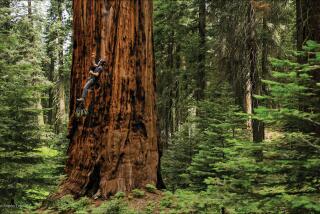East County Land Bought for Preserve
The Nature Conservancy of California and the state Wildlife Conservation Board have acquired land near El Cajon to be used as a preserve for threatened wildlife, including the least Bell’s vireo and the California gnatcatcher, officials said Monday.
The 496-acre parcel called Sloane Ranch provides “critical nesting and foraging habitat” for the least Bell’s vireo, a songbird that has been listed by the state and federal governments as an endangered species, said Scott Ferguson, a field representative for the Nature Conservancy.
Sloane Ranch is also home to other rare species, including the orange-throated whiptail lizard, the San Diego coast horned lizard and another songbird, the California gnatcatcher, Ferguson said.
The gnatcatcher was the subject of acrimonious debate during recent federal hearings in San Diego and Orange counties. At the hearings, developers lamented the effort to list the gnatcatcher as endangered, arguing that thousands of jobs and billions of dollars in profit would be lost if builders were barred from nesting grounds.
Sloane Ranch borders the Cleveland National Forest and Bureau of Land Management holdings east of El Cajon, between the Loveland and Sweetwater reservoirs. It includes about 1 3/4 miles along the Sweetwater River and Lawson Creek.
The land was purchased from the Bretz and Fisher families for $1.8 million, Ferguson said, the money coming from a 1988 state bond initiative to establish parklands and wildlife habitat. After two years of negotiations, the deal closed Thursday, Ferguson said. The preserve will be managed by a member of the Bretz family.
The stream-side forest terrain, or riparian habitat, is considered a rare collection of willow, sycamore and cottonwood forests. Also found on the preserve are chaparral and coastal sage scrub sites, on which grow several rare plants including the Dehasa nolina and San Diego thorn mint, which the state has listed as endangered.
The Sloane Ranch purchase might help quell the debate between San Diego builders and environmentalists, said C.J. Postma, vice president of planning for Home Capital Development Group, a subsidiary of HomeFed Bank. Other efforts to set aside undeveloped land as preserves are also in the works, Postma said.
More than half of the 3,000-acre development that Home Capital owns to the southeast of Sloane Ranch has been promised to the county as a natural preserve, Postma said.
Another cooperative effort by four local developers promises to set aside 4,000 acres of gnatcatcher and least Bell’s vireo habitat, Postma said. The project, called the Sweetwater-Loveland Open Space and Habitat Management Plan, is just east of Sloane Ranch and will be managed and maintained by the Nature Conservancy.
Environmentalists are encouraged by the recent purchase, saying it is a step toward the goal of a significant open-space preserve in San Diego County. It also is near two already established wildlife reserves at McGinty and Guatay Mountains.
“Having little 100-acre chunks of habitat isn’t going to help preserve species,” said Gary Bell, preserve manager for the Nature Conservancy. “If we are just protecting postage stamp-size parcels, there’s really no hope. This acquisition is key to connecting large areas.”
The Nature Conservancy is a nonprofit organization that acquires private land to preserve as open space. The Wildlife Conservation Board is the acquisition arm of the state Department of Fish and Game.
Sloane Ranch
The Nature Conservancy of California and the Wildlife Conservation Board have acquired land near El Cajon that will serve as a preserve for threatened habitats and wildlife, including the least Bell’s vireo and the California gnatcatcher. The 496-acre Sloane Ranch parcel was purchased for $1.82 million. Other protected areas near the Sweetwater River are McGinty Mountain, 766 acres, and Guatay Mountain, 521 acres, ecological reserves.
Source: The Nature Conservancy
More to Read
Sign up for Essential California
The most important California stories and recommendations in your inbox every morning.
You may occasionally receive promotional content from the Los Angeles Times.










